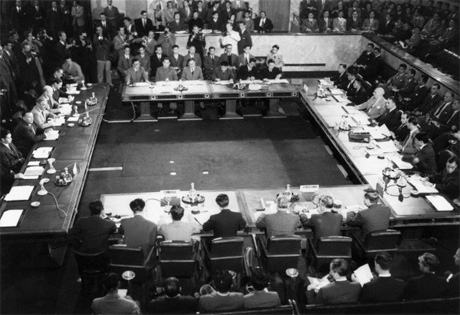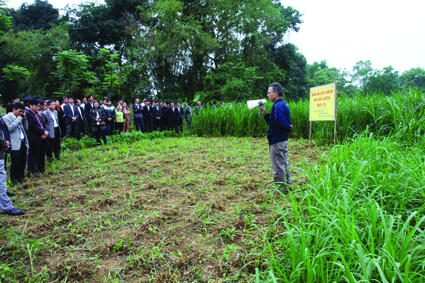Do Thanh Huyen[1]
UNDP Vietnam
Introduction
Good governance matters for development because it provides settings for public administration and thus for the provision of quality public goods and services. In the context of Vietnam being a low middle-income country, good governance is even more relevant since the transition to higher development levels is expected to meet higher demand and expectations from its citizens and society at large.[2]
In this context, urban governments (i.e. centrally governed municipalities) in Vietnam are experiencing new and more challenging governance tasks. Urban governments encompass a multitude of different stakeholders from greater demographical diversity and mobility. Healthier, more educated and wealthier urban citizens demand better quality public goods and services in order for them to bring into full play their potentials. While some citizens ask for being more actively involved in the socio-political and economic life (participation), others do so for transparent and verifiable information for their decision making in investing in their future, and some wish to keep authorities accountable to them when they pool resources for household and community development, as well as for honest public sector and corruption-free public services. In sum, urban governments are under more pressure to ensure that every stakeholder can exercise their legitimate rights and obligations.
Given the centralized state apparatus in Vietnam, urban governments of Hanoi, Hai Phong, Da Nang, Ho Chi Minh City (HCMC) and Can Tho tend to act as a one-step lower tier of the central government. They are mandated to operate as locomotives for regional socio-economic development.
Using the Vietnam Provincial Governance and Public Administration Performance Index (PAPI)[3] as evidence, this article portraits how citizens assess their municipal governments’ performance in four governance dimensions, including (i) how citizens are engaged in political life at the grassroots levels as prescribed in the Ordinance on Grassroots Democracy, (ii) how transparent different socio-economic policies are implemented in reality, (iii) how local governments are held accountable towards citizens or implement policies to encourage citizens in keeping local governments accountable to them, and (iv) how clean the local governments are when functioning public offices and mandate. By comparing the performance of the five municipalities and with the whole country, this article acknowledges efforts made to serve citizens better by the five municipalities, promotes peer learning of good practices, and suggests potential courses of action for improvement.
Key development indicators of centrally governed municipalities
Different in sizes and socio-economic endowments (see Table 1), the five municipalities are mandated to be ‘locomotives’ to pull other provinces in the course of Vietnam’s development. Among the five municipalities, Hanoi and HCMC are classified as special cities that serve as hubs to promote national development. Hai Phong, Da Nang and Can Tho are classified as Class 1 cities, functioning as national and regional development centers.[4] Da Nang is the smallest with nearly 1 million inhabitants, but the most urbanized (87% urban population). HCMC is home to nearly 8 million citizens and urban dwellers take up to 82.5%. Meanwhile, urban populations account for less than half of the populations of Hanoi and Hai Phong. Can Tho, the latest entry into the centrally governed municipality category has a population of 1.22 million, with 65% of urban inhabitants.
Table 1: Key Development Indicators of Five Centrally Governed Municipalities
| Key Development Indicators |
HCMC |
Hanoi |
Hai Phong |
Da Nang |
Can Tho |
| Total Population (National Statistical Year Book 2013) |
7.82 million |
6.94 million |
1.93 million |
0.99 million |
1.22 million |
| Urban Population |
(82.5% urban) |
(43.2% urban) |
(45.2% urban) |
(86.9% urban) |
(65% urban) |
| Gross Domestic Product (GDP) |
9.3% |
8.25% |
7.15% |
8.11% |
11.67% |
| Human Development Index |
0.773 |
0.770 |
0.744 |
0.761 |
0.751 |
| Poverty Rate |
0.1% |
3.6% |
5.1% |
2.5% |
5.9% |
| Adult Literacy Rate (General Statistics Office, 2010) |
94.59 |
97.13 |
96.66 |
97 |
97.23 |
| Key Governance Indicators |
|
|
|
|
|
| Provincial Governance and Public Administration Performance Index (PAPI) 2013 (Cecodes, VFF-CRT & UNDP, 2014) |
37.33 |
37.16 |
35.48 |
39.06 |
37.38 |
| Provincial Competitiveness Index (PCI) 2013 |
61.19 |
57.67 |
59.76 |
66.45 |
61.46 |
The five municipalities were at about the same level of human development scores reported in 2008, with their scores ranging from 0.74 (Hai Phong) to 0.77 (HCMC and Hanoi). Other human development indicators of notice are poverty rates and adult literacy. Can Tho has the highest reported rate of poverty (5.9%), while HCMC has the lowest (0.1%). On adult literacy, Hanoi, Da Nang, Can Tho and Hai Phong reported about 97% adult literacy rates in 2010, while HCMC reported about 94.6%. (See Table 1)
When it comes to aggregated governance indicators, differences between the five municipalities are interesting to note. Da Nang does much better than other four in both PAPI and the Provincial Competitiveness Index (PCI)[5]. At the national level, Da Nang’s PAPI and PCI scores in 2013 were among the top performers, with the sixth rank in the 2013 PAPI and first rank in the 2013 PCI. Meanwhile, Hai Phong ranks 48th in the 2013 PAPI but 15th in the 2013 PCI. Hanoi is seen to perform at the average level by citizens and businesses, with its 28th rank in PAPI and 33rd in PCI. HCMC and Can Tho see a larger difference in assessments by citizens and businesses. While both are average performers in PAPI, they are among the high performing group in PCI.
Nonetheless, aggregate indexes as such will not be helpful for understanding what works and does not work in local governments’ performance of their mandates and responsibilities in governance in a greater detail. Based on PAPI data, the next section presents specific issues with governance performance in the five ‘locomotives’ to examine how they are assessed by their citizens over time. It also indicates areas that need improvement and those that need consolidation and peer-learning for better governance in the five municipalities in particular and in upcoming urban centers in Vietnam.
How centrally governed municipalities fair in citizens’ assessment of governance performance
There is a large variance between the five municipalities in their aggregate PAPI scores when grouped into four performance levels (see Table 2). Da Nang stands out to be in the group of the best performers for three years in a row, thanks to its top-group scores in four out of six dimensions measured in PAPI. Hanoi and HCMC have consistently grouped in the high-average performing provinces. Both do pretty well in ensuring transparency and public service delivery. Can Tho emerged from the third group in 2011 to the second group in 2012 and 2013, with recognized weaknesses in public administrative procedures and public service delivery and a decline in its performance in vertical accountability. Meanwhile, Hai Phong remains in the poorest performing group despite little improvements in 2012, with the weakest areas being participation at local levels, vertical accountability and control of corruption. (See Table 2)
Table 2: PAPI 2011-2013 Scores of Five Cities by Four Performance Levels
| Municipalities |
Dimension 1. Participation at Local Levels |
Dimension 2. Transparency |
Dimension 3. |
Dimension 4. |
Dimension 5. Public Admin. Procedures |
Dimension 6. Public Service Delivery |
PAPI |
| Hanoi (2013) |
5.457 |
6.329 |
5.944 |
5.64 |
6.846 |
6.946 |
37.163 |
| Hanoi (2012) |
5.507 |
6.263 |
6.057 |
5.178 |
6.868 |
7.02 |
36.893 |
| Hanoi (2011) |
5.762 |
5.994 |
5.729 |
4.999 |
6.864 |
7.057 |
36.405 |
|
|
|
|
|
|
|
|
|
| Hai Phong (2013) |
4.724 |
6.062 |
5.179 |
5.236 |
6.846 |
7.43 |
35.476 |
| Hai Phong (2012) |
5.364 |
6.136 |
5.379 |
4.833 |
7.316 |
7.439 |
36.468 |
| Hai Phong (2011) |
5.179 |
5.307 |
4.773 |
4.595 |
7.01 |
7.332 |
34.197 |
|
|
|
|
|
|
|
|
|
| Da Nang (2013) |
5.229 |
6.669 |
5.942 |
6.334 |
7.515 |
7.374 |
39.064 |
| Da Nang (2012) |
5.466 |
6.105 |
6.036 |
6.822 |
7.47 |
7.65 |
39.549 |
| Da Nang (2011) |
5.278 |
5.456 |
5.79 |
6.084 |
7.332 |
7.43 |
37.371 |
|
|
|
|
|
|
|
|
|
| HCMC (2013) |
4.793 |
6.278 |
5.642 |
6.306 |
7.074 |
7.233 |
37.326 |
| HCMC (2012) |
4.743 |
5.798 |
5.144 |
6.367 |
7.076 |
7.517 |
36.645 |
| HCMC (2011) |
5.143 |
6.006 |
5.24 |
6.148 |
7.081 |
7.148 |
36.766 |
|
|
|
|
|
|
|
|
|
| Can Tho (2013) |
5.39 |
6.046 |
5.168 |
7.175 |
6.845 |
6.753 |
37.377 |
| Can Tho (2012) |
5.815 |
5.453 |
5.652 |
6.217 |
6.851 |
6.766 |
36.755 |
| Can Tho (2011) |
5.717 |
5.491 |
5.547 |
5.951 |
6.353 |
6.55 |
35.61 |
-
| Color code: |
Best performer |
Above 75th percentile |
Low Average |
Between 25th and 50th percentile |
|
|
High Average |
Between 50th and 75th percentile |
Poor Performer |
Below 25th percentile |
Source: Cecodes, VFF-CRT & UNDP, 2011, 2012 & 2013 (available at www.papi.vn)
As shown in the 2013 PAPI Report, among the five municipalities, Hanoi stands out as the one with larger differences in citizen experience.[6] It indicates some level of inequality in governance in the capital city, as some citizens experience an elite service of high efficiency while others access to poorer governance quality. Hanoi is also consistent low scores in control of corruption in the public sector over three years. In addition, as the PAPI report points out, women, the poor and ethnic minorities rate governance performance quality of Hanoi authorities lower than other population groups. Other four municipalities see much narrower gaps in their citizen experiences.
Differences in governance performance between the five municipalities can be illustrated with more concrete evidence at the sub-dimensional and indicator level. They can be seen through 2013 findings as illustrated in Figure 1, and in selected indicators in the first four dimensions (noting that the five municipalities are doing relevative well in providing public administrative procedures and public services). (See Figure 1)
Figure 1: Sub-dimensional Scores of Five Municipalities (2013)

Participation in political life at the grassroots levels. Enhancing citizen awareness of grassroots democratic rights and creating opportunities for every citizen to participate effectively in political activities and policy making remain key challenges facing the five municipalities as well as other provinces. All five performed at the average level in this dimension (see Figure 1a, where the upper red line shows the highest possible provincial score, the middle red line shows median provincial score, and the lower red line shows the lowest provincial score).
When each specific indicator constituting this dimension is examined, HCMC got the lower average score because of the fact that their citizen knowledge of grassroots democracy rights was more limited than their peers. Only 29% of respondents to the 2013 PAPI questionnaire were aware of the Grassroots Democracy Ordinance (GDO), and about half heard of the popular slogan “people know, people discuss, people do and people verify” for the GDO. This is contrary to the case of Da Nang where 46% of the respondents said they were aware of the GDO, and 93% were aware of the slogan.
Another example about how citizens actually participated in political life is through their own experience with elections of citizen representatives for the National Assembly and People’s Councils at different levels. When asked if they participated in recent 2011 National Assembly and People’s Councils elections, a low proportion of respondents said ‘yes’. Citizens in Can Tho seem to be more active as 71% said they participated in the People’s Council elections, and 64% in National Assembly elections. Other four municipalities had below 55% of respondents report having participated in both elections. These low rates in elections for 2013 were also seen in 2011 and 2012, suggesting there is a gap between actual election participation and what is officially reported.[7]
Participation in decision making when citizens are called for voluntary contribution is also low in the five municipalities. If 63% of respondents from Hanoi said they contributed voluntarily (as opposed to coercive requests by local authorities) to community public works in 2013, only 36% of those said they partook in decision making when starting the projects. In HCMC, only 33% of respondents said their contribution to public works was voluntary, and 26% participated in decision making before the projects commenced. In other three municipalities, the reported proportions in both indicators were very low.
The gap in performance from the highest provincial score shows that more serious efforts should be undertaken to actively engage citizens in local political and social life. The election principle of “one person, one vote” should be fully observed and recorded properly. Substitute voting should not be accepted at any cost. Local election committees should have incentives for being honest in registering and counting votes. Independent election observers should be invited to randomly check the compliance with election regulations, especially in National Assembly and People’s Council elections. Now that the Constitution Amendment in 2013 has given constitutional rights to the National Election Council under Article 117, transparent and accountable election regulations and mechanisms should be put in place for the Council to properly oversee elections.
Transparency. As required by GDO, information, processes and results of three policy aspects PAPI measures (including ‘poverty lists’, ‘commune budgets’ and ‘land-use planning and pricing’) are made publicly available in a transparent manner so that citizens can “know, discuss, do and verify”. Figure 1b shows that transparency in the three areas falls short from what is expected from effective implementation the GDO in the five municipalities.
All five governments did not perform well enough when compared with the province with the highest score (Quang Binh at 6.87 points) and the highest maximum score of 10 points. Overall, Da Nang did better than other four municipalities with its dimensional score being closest to the highest provincial score. Of the three areas measured, the five municipalities performed not so well in transparency of land use plans and land price frames. Da Nang and Can Tho did a little better than Hai Phong. Hanoi and HCMC got almost similar scores.
The 2013 PAPI findings show that land administration is the least performing area in terms of transparency at the local levels. Only 20% of the respondents on average said they were aware of land use plans and land price frames. Among the five municipalities, there is a great deal of variances in the percentage of respondents aware of local land plans: 13% in Can Tho, 19% in Da Nang, 21% in HCMC, 23% in Hai Phong and 37% in Hanoi. Of these, only 3% in Can Tho had a chance to comment on land plans, as opposed to 18% in Hanoi. For most of the respondents affected by the land plans in the five municipalities, the plans did not benefit their households. When asked if the compensations to those affected were close to market land prices, only 31% agreed in Can Tho as opposed to none in Da Nang and HCMC. Furthermore, when asked if citizens want to know local land price frames as published by local governments, ranging between 41% and 61% of respondents from these five municipalities know where to go to get the information.
The lack of transparency in land administration, land planning and land pricing at the local level as such may have attributed to the increasing number of complaints and denunciations sent to central government agencies. As reported by official sources, as high as 70% of complaints and denunciations have been about land-related issues.[8]
The PAPI findings from the five municipalities thus imply that serious actions need to be taken in order to make land plans and land price frames transparent to the public at all government levels. Apart from publishing information on government portals as the municipalities are doing, local governments should post land master plan maps and/or five-year land plan maps in accessible places for citizens to be aware of land plans in their respective districts. For annual land plans and land price frames, they should be posted at ward/commune People’s Committee notice boards in addition to being sent to residential group/village heads for informing residents through notice boards or personal consultation. Doing so will help ease citizen access to such important land information.
Vertical Accountability. PAPI looks into how local governments are held accountable to citizens and implement mechanisms to engage citizens in monitoring the performance of local governments. The mechanisms can be in the form of regular or ad-hoc interactions with local authorities or grassroots institutions like the People’s Inspection Boards (PIB) and the Community Investment Supervision Boards (CISB). The 2013 PAPI data shows that the five municipalities have a great deal of work to catch up with other provinces.
As illustrated in Figure 1c, all of the five municipalities are around and below the median score, indicating that the municipal governments performed at the average or low level in vertical accountability towards their citizens. Hanoi seems to do better in terms of creating more opportunities for citizens to exercise their oversight roles through PIBs than HCMC. Da Nang does better in frequency and effectiveness of local governments’ interactions with citizens, while Can Tho lags behind.
Grassroots public officials do not seem to play important roles in city dwellers’ life as very few citizens go to contact them when they have any problems concerning their families, communities or local governments. For instance, only 1% and 5% of the respondents in Hai Phong and Hanoi, respectively, have interacted with their village heads; meanwhile, the largest percentage among the five municipalities is at 36% in Da Nang, followed by 34% in HCMC. Except in Hanoi, those who have contacted village heads in the rest four municipalities appreciated the advice and support received. The same pattern is seen in citizen interactions with commune-level public officials, with very few respondents having met these grassroots officials for support in the five municipalities (with some exception in HCMC where 21% of the respondents went to meet commune officials).
Legitimate people-elected oversight mechanisms including PIBs and CISBs are not so visible by citizens of the five municipalities. Except for Hanoi where 56% and 21% of the respondents said their villages have PIBs and CISBs respectively, very few citizens in other four municipalities are aware of their existence. Hai Phong citizens saw much less effectiveness of these boards in comparison with other municipalities.
Some measures to improve vertical accountability may be to embed regular public hearings in bi-weekly or monthly workplans of municipal, district and commune People’s Councils where applicable with the participation of key local authorities. Public officials and civil servants should be equipped with mandates and skills to speak, hear, interact and explain different policy issues to concerned citizens. Furthermore, PIBs and CISBs should be granted greater autonomy (rather than being influenced by local authorities) with more resources in the form of either additional allocation of state funds (which is conventional) or mobilization of local residents’ skills and resources (which is more non-conventional but is being done in quite a few urban resident areas).
Control of Corruption in the Public Sector. Measuring how local governments are implementing anti-corruption measures constitutes an important dimension of PAPI. PAPI does so by looking into how local governments, public officials and civil servants are resistant of corrupt practices when providing public services to citizens and how anti-corruption efforts are being taken by them. The 2013 findings show that there is a large difference in anti-corruption performance between the five municipalities (see Figure 1d). Can Tho is the 5th of the country, while Hai Phong ranked the 58th. Da Nang and HCMC are at the average levels, while Hanoi falls in the low average group. Nepotism for jobs in the public sector seems to be more prevalent in Hanoi and Hai Phong than in Can Tho and HCMC. Can Tho does much better in controlling corruption in state management agencies than the rest four municipalities. Hai Phong lags much behind in terms of efforts to control petty corruption in provision of public healthcare and primary education services. Willingness to fight against corruption by both local governments and citizens is much more limited in Hanoi and Hai Phong than other three southern municipalities.
A deeper look into specific indicators shows that northern municipalities (Hanoi and Hai Phong) performed much less effectively in control of corruption than southern ones. More citizens of Hai Phong and Hanoi experienced requests for bribes when applying for land use rights certificates (with 47% in Hai Phong and 50% in Hanoi denying having to pay bribes for land use right certificates (LURCs), using public district hospital services (with 35% in Hai Phong and 34% in Hanoi denying), and applying for jobs in the public sector (with 19% and 32% denying responsively). Fewer Can Tho citizens had such experiences among the five municipalities. Of those who applied for LURCs, 14% in Hai Phong reported they paid bribes and the average estimated amount was 1.4 million VND - lower than Hanoi in frequency (63%) and in size (2.6 million VND). The average size of bribes asked for in Can Tho was barely at 3,135 VND and this was experienced by 43% of LURC applicants. In addition, Hanoi citizens experienced a bigger average size of bribes at public district hospitals (2.9 million VND) than all other four municipalities. It was also more expensive in bribes for better quality primary education in Hanoi (with the estimated average size of bribes of 2.6 million VND).
Knowledge of the Anti-corruption Law may help citizens keep local governments accountable and quest for better performance in control of corruption. Nonetheless, about half of the populations in the five municipalities said they were aware of the Law, with a slightly higher percentage of respondents in Da Nang reported positively. In all five municipalities, less than half of the populations agreed that their local governments were serious about anti-corruption with the percentages ranging from 32% to 49%. The most starking difference is in the indicator on citizen tolerance with requests for bribes. In Can Tho, when the bribe amount reached 4.2 million VND on average, citizens would start denunciating. In Hanoi, the average toleratable amount reported in 2013 was 11.6 million VND, almost tripling the toleratable amount in Can Tho. Having noted that, about 6% of victims of corruption in Hanoi said they reported to relevant authorities, while citizens in other four municipalities did not report at all.
Such evidence shows that Hanoi and Hai Phong authorities have more work to do to control corruption in their offices and in public service delivery. To catch up with other provinces in control of corruption, the municipal authorities need first and foremost to take citizen feedback seriously, mitigate ‘nepotism’ and the negative practice to ‘pay for state employment’ in recruitment of civil servants. Can Tho’s experiences may be of relevance to other municipalities to learn from. In addition, improved transparency in LURC related procedures and will help mitigating undertable undertakings at one-stop shops. Municipal authorities may request district public hospitals to put in place surveillance facilities to monitor everyday interactions between healthcare workers and their clients. Public hospital administrations need to observe and exercise the ethical standards while creating better incentives for healthcare workers to ensure their livelihoods. Changes can be made only if recruitment of new entry healthcare workers is free of nepotism and corruption. Similar recommendations can be applied for public primary schools.
Conclusions
This article has provided citizen-based evidence to reflect on what works and what does not work in urban governance in the five socio-economic locomotives of Vietnam. The evidence shows that while taking on important roles to be example for other regional provinces to follow, the municipalities still have room for self-reflection and improvement.
The performance by the five municipalities in urban governance (including participation at local levels, transparency, vertical accountability, and control of corruption) is at different levels. In particular, Hanoi and Can Tho did a little better in participation at local levels compared to other four municipalities; Da Nang and HCMC were rated higher in transparency; Hanoi and Da Nang performed better in vertical accountability; and, Can Tho and Da Nang did better in control of corruption. However, all still fall behind other ordinary provinces in aggregated provincial dimensional scores, except for Da Nang to be the second best performer in transparency and Can Tho the third in control of corruption.
Concrete measures may vary from one municipality to the other. Some suggested options for change have been introduced earlier. But the first and foremost solution lies in the proactiveness of the municipal authorities in engaging citizens in everyday political and monitoring activities at the grassroots levels, in facilitating the effective operation of available legitimate oversight mechanisms (PIBs and CISBs) to monitor the quality of work by grassroots authorities, in facilitating more frequent interactions with citizens to hear their concerns, in enhancing transparency in recruitment of civil servants and public employees, and in addressing and mitigating corrupt practices in the public sector.
The municipalities also could take initiatives in sharing good practices and experiences with their peers. For instance, Hanoi could take extra miles to catch up with HCMC in control of corruption, while the latter could learn from the former in participation at local levels and vertical accountability. Hai Phong could learn from good practices being appreciated by citizens in Da Nang and Can Tho, particularly in vertical accountability and control of corruption.
As PAPI evidence shows, emerging challenges facing urban governments differ from one municipality to another. They however should be seen as opportunities for change and improvements. As the country is striving to develop and sustain new levels of development amidst higher educational levels of citizens, engaging citizens in policy making and acknowledging their legitimate expectations will help the municipalities move forward in improving governance performance. Being locomotives for other provinces, they can create spill-over effects for other neighboring provinces to follow suit once they perform well.-
[1] Policy Analyst, Public Administration Reforms and Anti-corruption Policy Advisory Portfolio, United Nations Development Program (UNDP) in Vietnam. The author thanks the PAPI Research Team (i.e., Mr. Jairo Acuña-Alfaro, UNDP Policy Advisor and PAPI team leader, Dr. Edmund J. Malesky, Dr. Dang Ngoc Dinh and Dr. Dang Hoang Giang) for their inspiration and analytical work done for PAPI, and Mr. Jairo Acuña-Alfaro in particular for his review of and substantive contribution to the article. Views expressed in this article are my own.
[2] See Government of Vietnam (2011). Vietnam’s Socio-Economic Development Strategies for the period of 2011-2020.
[3] See CECODES, VFF-CRT & UNDP (2014). The Vietnam Provincial Governance and Public Administration Performance Index (PAPI) 2013: Measuring citizens’ experiences. Hanoi. Also available at www.papi.vn.
[4] See Government of Vietnam (2009). Decree No. 42/2009/ND-CP on Classification of Cities, dated May 7, 2009.
[5] See Malesky, Edmund et al. (2014). The Vietnam Provincial Competitiveness Index: Measuring economic governance for private sector development. 2013 Final Report. Vietnam Competitiveness Initiative Policy Paper 14. Vietnam Chamber of Commerce and Industry (VCCI) and United States Agency for International Development’s Vietnam Competitiveness Initiative (VNCI). Hanoi, Vietnam.
[6] See Cecodes, VFF-CRT & UNDP (2014, Figure 2.1, p. 23)
[7] See reported election results by the Election Council at https://baucukhoa13.quochoi.vn/default.asp?page=newsList&ID=47&menu=1 [accessed on July 18, 2014)
[8] See Ban Nội chính Trung ương (05/04/2014). Một số vấn đề về khiếu nại, tố cáo và giải quyết khiếu nại, tố cáo trong lĩnh vực đất đai [Commission for Internal Affairs (05/04/2014). About complaints, denunciations and complaint and denunciation handling in land administration]. URL: https://noichinh.vn/nghien-cuu-trao-doi/201404/mot-so-van-de-ve-khieu-nai-to-cao-va-giai-quyet-khieu-nai-to-cao-trong-linh-vuc-dat-dai-294276/ [Accessed on July 18, 2014]









